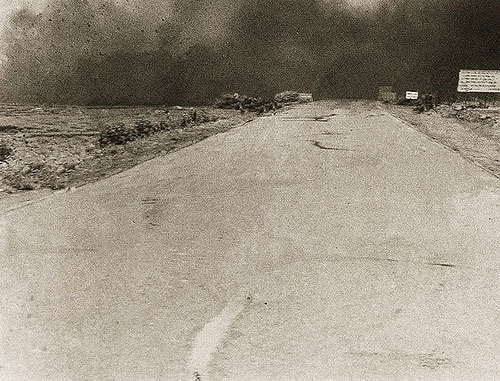A Theme With Variations

The other day, Michael David Murphy had a post with an image and two variations (modification), and that had me thinking. The first, original image is Nick Ut’s well-known photo of soldiers and Vietnamese napalm victims. In a nutshell, it also stands for photojournalism, circa around the time it was taken. (more; updated)
The second image, by Josh Azzarella, shows the same scene, but now the Vietnamese children are missing. You could easily argue that’s photojournalism today, as reproduced in the media: We get to see the troops (“soldiers” became “troops”), but we don’t get to see the victims of bombings any longer. Along with the victims in the photographs, the previously vocal anti-war movement has also vanished.
The third image - shown above - from Pavel Maria Smejkal’s Fatescapes, has every human removed - napalm victims and soldiers alike. Following the above, that could be taken for the state of fine-art photography today. The abstraction of war is complete. All that’s left to remove is the landscape - to leave us with complete emptiness.
Make no mistake, that’s probably not how and why these variants were produced, but still… It’s so tempting to make those connections.
This morning, I found a quote that might go along all of this, from a post by Colin Pantall. Speaking about her new book, Susie Linfield wrote
“a lot of what passes for ‘visual literacy’ today is merely visual cynicism. People, especially young people, are very used to saying ‘photographs lie,’ to pointing out how images are manipulated by Photoshop or other means. Such suspicion and skepticism isn’t entirely bad, but I don’t think of it as visual literacy. I don’t urge naïve acceptance or cynical rejection of photos of political violence; the book makes a plea for us to use photographs of atrocity as starting-points to engage with very complicated histories and very specific political crises. If we want to construct a politics of human rights that isn’t merely an abstraction, we need to look at these photographs of suffering, degradation, and defeat. We need to think clearly not only about the relationships among these images, how they function and what they communicate in aggregate, but about the specific conditions each one depicts, no matter how disturbing, shaming, and bewildering an experience that may be.”
It’s time to have such a debate now. It’s time to add things back in. By “things” I ultimately mean us. We need to add ourselves back in.
Update (16 November 2010): There’s a follow-up post here.